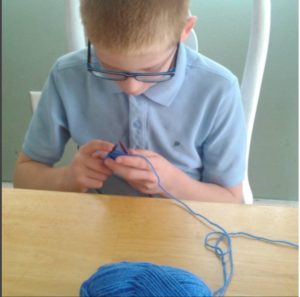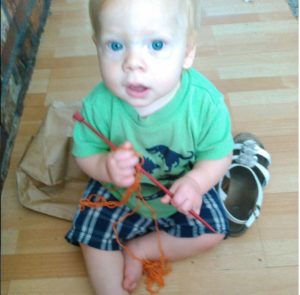Teaching Children to Knit
I have this strange desire for my children to share my interests. Maybe it’s not so strange, I don’t know. But it’s there. The problem with this is that I only have sons. And that I’m not particularly interested in things like Star Wars and Legos. I’ve tried teaching them to knit and crochet in the past anyway, with varying degrees of success. Today I’ll share a few of the tips I’ve gleaned from other sources on teaching children to knit.
Don’t force them.
 This is a hard one for me because I really want my boys to learn the craft. But generally speaking, they’re mildly interested at best, but not at all interested more often. Forcing children to do something they don’t want to do, as any parent knows, usually just makes things worse.
This is a hard one for me because I really want my boys to learn the craft. But generally speaking, they’re mildly interested at best, but not at all interested more often. Forcing children to do something they don’t want to do, as any parent knows, usually just makes things worse.
Sit next to them, not across from them.
An adult has the ability to understand opposite hands a lot easier than a child. So when you take an adult knitting class, you might find yourself sitting across from the instructor, and you know you need to do the opposite of what you see, but children have a hard time mimicking that way. It’s best to sit next to them while you’re showing them what to do so they can see the actions the way they actually need to be performed.
Help them with their work. Don’t try to show them on your own needles and yarn.
 This was the hardest part for me to figure out. When I took my class, the instructor had her yarn and needles, and each pupil had theirs. She showed us by doing it herself. When I tried to teach Munchkin (11 now, but we started when he was 9) to knit following this method, it didn’t work out so well. He could cast on just fine, but struggled to actually knit. When I held his hands and guided them in the proper motions, he had a lot more success.
This was the hardest part for me to figure out. When I took my class, the instructor had her yarn and needles, and each pupil had theirs. She showed us by doing it herself. When I tried to teach Munchkin (11 now, but we started when he was 9) to knit following this method, it didn’t work out so well. He could cast on just fine, but struggled to actually knit. When I held his hands and guided them in the proper motions, he had a lot more success.
If your child is younger, you might even do part of the work for them on a fairly regular basis, especially in the beginning. With Small Fry (5), I cast on for him, and then taught him how to put the needle through the stitch. I then wrapped the yarn, but taught him to pull the yarn back through. This way, he was doing 2/3 of the work (and so still learning), but by not having him work the yarn he didn’t have to learn (yet) the most difficult part of knitting: manipulating yarn and needles together.
Keep it simple.
While knitting boils down to just two stitches (knit and purl), they can be combined in dozens of ways to make stunning garments. But when you’re first learning, it’s best to work for a long time on just the basics. When teaching a child, I recommend letting them work with just the knit stitch for a long time. Knitting is easier than purling, so make the, very comfortable with knitting before you add in purls.
Ultimately, there’s not really a right or wrong way to teach them to knit. These tips are just some I’ve come across online and in my own experience with my boys.
Blessings,


